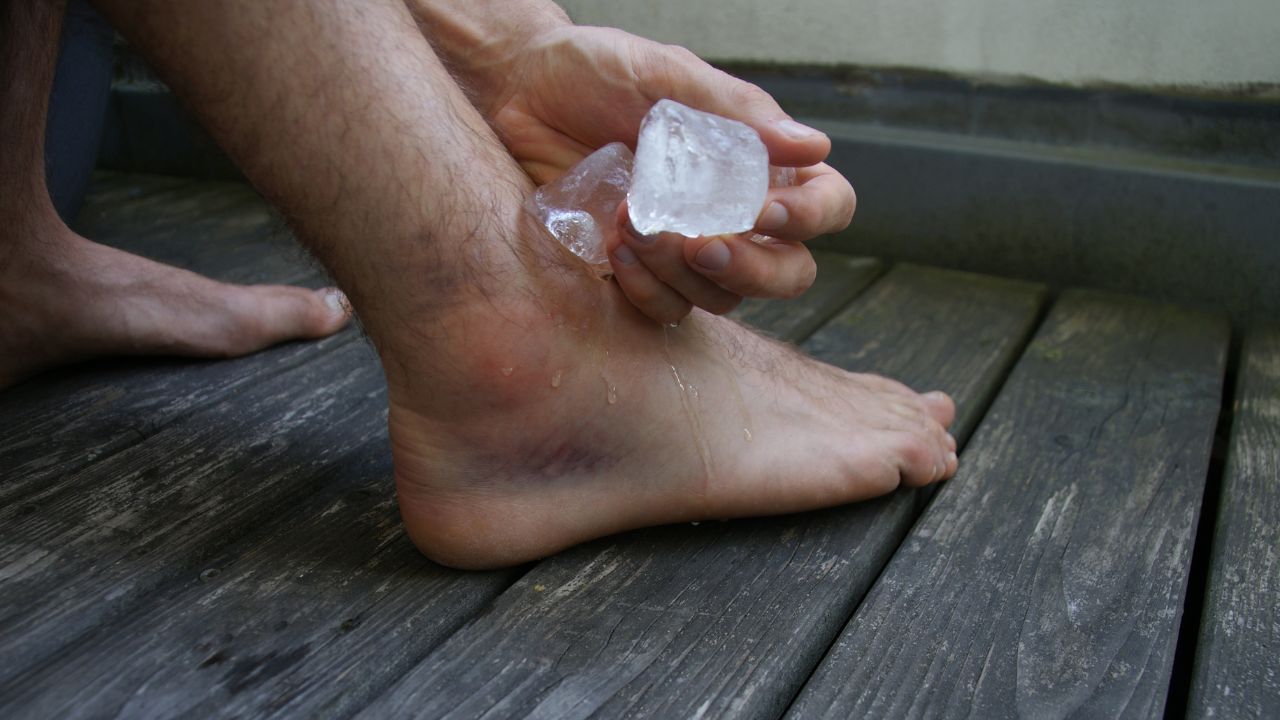
A sprained ankle is a common injury that occurs when the ligaments that connect the bones in the ankle joint are stretched or torn. It can happen due to twisting, rolling, or landing awkwardly on the foot. A sprained ankle can cause pain, swelling, bruising, and difficulty walking or bearing weight on the affected foot.
A sprained ankle can range from mild to severe, depending on the extent of the damage to the ligaments. Most sprained ankles can heal with proper home care and self-management, but some may require medical attention and treatment. In this article, Trendbbq will show you how to treat a sprained ankle using four simple steps: rest, ice, compression, and elevation (RICE). Let’s find out!
Table of Contents,
1. How to Treat a Sprained Ankle with Rest
When you find yourself dealing with a sprained ankle, knowing how to treat a sprained ankle is crucial. The first step in this process revolves around providing your injured foot with the rest it deserves. This period of rest plays a pivotal role in mitigating inflammation, alleviating pain, and preventing any further harm to those delicate ligaments. It’s essential to steer clear of activities that exert pressure or strain on the affected ankle – activities like walking, running, jumping, or engaging in sports should be temporarily avoided. And don’t forget about your choice of footwear during this time; opt for comfortable shoes that are neither tight nor high-heeled.
For the initial phase following the injury, dedicate a minimum of 48 hours to resting your ankle. This timeframe should extend until the pain and swelling start to ease off. However, it’s worth noting that complete immobilization isn’t advisable, as it could hinder the healing process and lead to stiffness or weakness. To maintain some degree of range of motion and promote healthy blood circulation, make it a habit to gently move your ankle in various directions every few hours.
2. How to Treat a Sprained Ankle with Ice
When it comes to addressing a sprained ankle, the second crucial step in the healing process involves the application of ice. Ice serves as a valuable ally in reducing swelling, inflammation, and the discomfort associated with the injury. It achieves this by constricting blood vessels and temporarily numbing nerve endings. Timing is essential here; the sooner you apply ice after the incident, the better. Aim to repeat this process at intervals of 15 to 20 minutes within the initial 24 to 48 hours.
You have a few options for applying ice to your ankle. An ice pack works well, as does a bag of frozen peas or even a cloth-wrapped around ice cubes. However, a word of caution – avoid direct contact between the ice and your skin to prevent potential frostbite or nerve damage. To ensure your safety, wrap the ice pack or bag in a thin cloth or towel. This protective layer shields your skin from extreme cold, reducing the risk of cold burns during the icing process.

3. How to Treat a Sprained Ankle with Compression
The third crucial step in the process of effectively treating a sprained ankle: providing the injured area with the right kind of support. This step involves the application of a bandage or an elastic wrap, a key move in managing swelling, inflammation, and potential bleeding. How does it work? By gently exerting pressure and offering stability to those tender ligaments.
But here’s the thing – you need to strike a balance. The wrapping should be snug enough to be effective, but not so tight that it hinders blood circulation or exacerbates the pain and damage. That’s where choosing the right materials comes in. You can opt for an elastic bandage, an ace wrap, or a compression sleeve for this purpose. What you should avoid are tapes or plastic wraps, as they might restrict blood flow and potentially cause skin irritation.
Here’s a pro tip: Be mindful to leave a bit of room between your toes and the heel of the wrap. This ensures that there’s some freedom of movement and adequate circulation.
When you’re wrapping, start from your toes and work your way upwards, going just above the ankle joint. Overlap each layer by about half to ensure even compression and support. Remember, it’s crucial to keep an eye on how it feels. If it becomes loose or uncomfortable, make those necessary adjustments.
Lastly, it’s important to remove the wrap when you’re going to bed or elevating your foot. This gives your ankle the chance to breathe and ensures that you’re not putting undue pressure on it during rest. This step-by-step approach should help you effectively manage a sprained ankle while promoting a healthy recovery.
4. How to Treat a Sprained Ankle with Elevation
Elevating the injured foot above the level of your heart can be a game-changer when it comes to reducing swelling, inflammation, and the accompanying pain. It works by facilitating the drainage of excess fluid and blood from the affected area. This step is particularly vital within the initial 48 hours following the injury or until you notice a significant reduction in swelling.
To achieve proper elevation, you can employ everyday items like pillows, cushions, or blankets. These come in handy for propping up your foot on a bed, couch, or chair. However, it’s important to note that you should avoid the temptation to let your foot hang over the edge of the furniture, as this could inadvertently lead to more swelling or added pressure on the ankle. Similarly, refrain from crossing your legs or bending your knee during this process, as these actions might hinder blood flow or exacerbate discomfort. Remember, the goal here is to promote healing and alleviate swelling, so proper and comfortable elevation is key.
5. How to Prevent Sprained Ankles
Dealing with a sprained ankle can be quite a hassle, often resulting from accidents or unforeseen injuries that catch us off guard. However, there are practical steps you can incorporate to either minimize the risk of sprained ankles or mitigate their severity. Let’s explore some useful strategies, while also keeping in mind the keyword “how to treat a sprained ankle.”
- Selecting the Right Footwear: Begin by paying attention to your choice of footwear. Opt for shoes that not only fit snugly but also offer optimal comfort, support, and stability. This simple decision can go a long way in preventing sprained ankles. Avoid footwear that’s either too tight, too loose, excessively high, or significantly worn out. Moreover, ensure that your choice of shoes matches the specific activity or terrain you’re engaging in.
- Prepping with Warm-ups and Stretches: Before diving into any physical activity, it’s crucial to warm up your muscles, joints, and ligaments. Engaging in light exercises such as jogging, skipping, or even some gentle jumping can increase blood flow and enhance flexibility. Incorporate stretching exercises like ankle circles, toe raises, or heel drops to limber up those ankles and reduce the risk of a sprain.
- Enhancing Strength and Balance: Strengthening the muscles, joints, and ligaments surrounding your ankles is another proactive measure. Exercises like calf raises, ankle pumps, and single-leg stands can significantly boost your stability and strength, thus minimizing the vulnerability to sprains. To further bolster your balance and coordination, consider utilizing tools like resistance bands, balance boards, or wobble cushions in your routine.
- Navigating Hazards with Care: When it comes to preventing sprained ankles, it’s crucial to stay alert to your surroundings. Take extra care when walking, running, or engaging in sports on surfaces that are potentially slippery, sloped, or rocky. Keep a watchful eye for hazards like uneven ground, wet floors, or loose objects that could trigger an ankle twist or roll.
6. When to See a Doctor for Sprained Ankles
Most sprained ankles can heal with proper home care and self-management, but some may require medical attention and treatment. You should see a doctor for sprained ankles if you have:
- Severe pain or swelling: Severe pain or swelling in your ankle may indicate a more serious injury, such as a fracture, a dislocation, or a complete tear of the ligament. You should seek immediate medical help if you have severe pain or swelling that does not improve with rest, ice, compression, or elevation.
- Inability to walk or bear weight: Inability to walk or bear weight on your injured foot may indicate a more serious injury, such as a fracture, a dislocation, or a complete tear of the ligament. You should seek immediate medical help if you cannot walk or bear weight on your foot without severe pain or difficulty.
- Signs of infection or nerve damage: Signs of infection or nerve damage in your ankle may include fever, redness, warmth, pus, numbness, tingling, or weakness. You should seek immediate medical help if you have any signs of infection or nerve damage that do not improve with rest, ice, compression, or elevation.
- Persistent or recurrent symptoms: Persistent or recurrent symptoms in your ankle may indicate a chronic condition, such as arthritis, tendonitis, or instability. You should see your doctor if your symptoms last for more than six weeks or recur frequently despite proper home care and self-management.

A sprained ankle can range from mild to severe, depending on the extent of the damage to the ligaments. Most sprained ankles can heal with proper home care and self-management using four simple steps: rest, ice, compression, and elevation (RICE). However, some sprained ankles may require medical attention and treatment. In this article, we showed you how to treat a sprained ankle using the RICE method. We also gave you some tips on how to prevent sprained ankles and when to see a doctor.
7. FAQs
7.1. What should I do immediately after spraining my ankle?
The first step is to rest, elevate, and ice the injured ankle. This helps reduce swelling and pain. Avoid putting weight on it if it’s painful to do so.
7.2. Is it necessary to see a doctor for a sprained ankle?
Most minor to moderate sprains can be treated at home with rest, ice, compression, and elevation (RICE). However, if you suspect a severe sprain, a fracture, or if the pain doesn’t improve within a few days, it’s advisable to see a healthcare professional.
7.3. How long should I rest my sprained ankle?
The duration of rest depends on the severity of the sprain. Minor sprains may require a few days of rest, while more severe ones might need several weeks. Follow your doctor’s recommendations.
>>> See more: How to Reduce Fever: A Guide for Effective Methods



